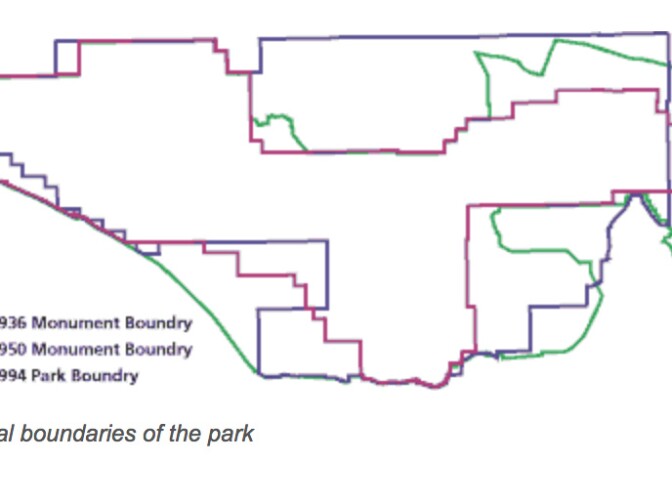With our free press under threat and federal funding for public media gone, your support matters more than ever. Help keep the LAist newsroom strong, become a monthly member or increase your support today.
Are CA national monuments at risk in Trump review? Joshua Tree could be a guide
This week President Trump issued an executive order asking for a review of all national monuments created since 1996 that are more than 100,00 acres, a list that includes seven in California. He indicated he might want to reduce or even eliminate some that impede energy development or economic growth. Monument boundaries are not set in stone, but they tend to get bigger over time, not smaller. However, Southern California is home to a notable exception.
Joshua Tree National Monument was controversial from the moment it was created in 1936 by President Franklin Delano Roosevelt. There were thousands of mining claims in the 825,000 square acre monument, mostly gold, but also iron. By law, existing mines were allowed to operate, but no new claims could be developed. And that was the problem for some.
“Immediately the miners began to kick up a ruckus about it and all sorts of mining associations formed to challenge it,” said Lary Dilsaver, a retired University of Southern Alabama professor who wrote a book about the history of Joshua Tree.
After years of lobbying, the miners convinced their US congressman to introduce a bill to shrink the size of the monument, carving out some of the more promising mining districts. It was an ugly battle that pitted conservation against extraction. It came to head at a heated forum on mining in the monument held at the San Bernardino County Courthouse in 1946. World War II had just ended, and many miners were concerned that the minerals needed to prepare for future conflicts were now off-limits.
“If we can't prospect and we are caught in another war, where are we going to get our strategic minerals?” asked miner W. B. Clemenger, who is quoted in Dilsaver’s book.
Conservationists like LA-area botanist Edmund Yeager, however, took the long view.
“It is time this community in Southern California and the people of the United States look a little bit to the future and not simply down the end of our noses and our own immediate living,” he said.

Ultimately, the miners won the battle. In 1950, Congress passed a law reducing the size of Joshua Tree National Monument by a third. Soon, the Kaiser Steel Corporation had opened a huge open air mine -- the largest in the Western United States -- on former monument land. It operated until 1982, supplying iron ore for Kaiser’s smelter in Fontana. After that, local conservation groups engaged in a protracted battle with the city of Los Angeles over a proposal to turn the open pits into a gigantic landfill. In 2013, the city relented.
Mark Butler, the former superintendent of Joshua Tree National Park from 2011 to 2014 (the monument became a park in 1994), calls what transpired “a cautionary tale of economic shortsightedness and loss of our national heritage.”
The iron mine, along with many others dotting the area carved out of the original monument territory, are now abandoned. But the industrialization of the surrounding land is irreversible.
“They’re done. They came there, they made money, they damaged the landscape and they left the National Park Service or the Bureau of Land Management with the residual. Their economic contribution is over,” he said. “On the other hand, the outdoor recreation economy will continue to contribute to that local community, year after year after year.”
According to park officials, Joshua Tree contributed nearly $165 million dollars to the local economy last year. The park also experienced record – and some say overwhelming – visitation.

Now, there’s a plan to add back to the park some of the land that had been part of the monument prior to 1950 (some lands were added back in 1994). David Lamfrom, director of the California Desert Program for the National Parks Conservation Association, said one benefit of doing so would be to ease the visitor pressure on existing park resources, “to disperse that visitation to new places.”
All three men say what happened in 1950 mirrors the debate today over conservation versus energy independence and economic growth.
“It’s the same old, same old,” said Dilsaver.
One key difference is that Joshua Tree National Monument was reduced in size by an act of Congress, not an executive order. Legal scholars are divided over whether the president has the authority to reverse a monument designation unilaterally.










